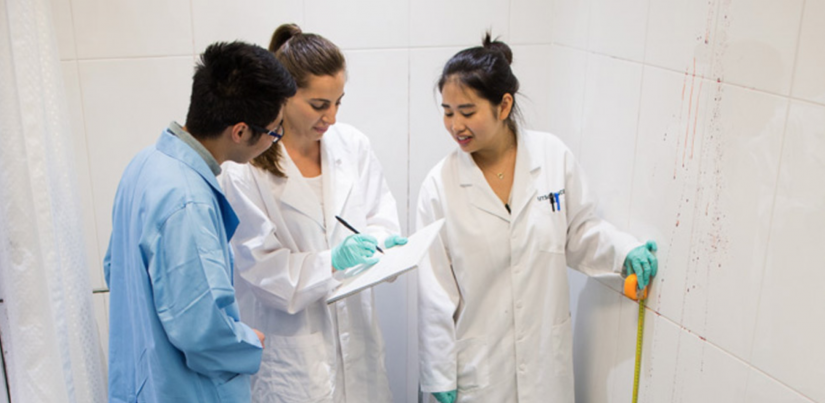Technology is not only leading to new types of crime, but new ways to fight it too. The ‘Australian formula’ was recently recognised globally as the best standalone technique for visualising latent fingerprints on paper.

Forensic science students investigating a mock crime scene. Photo by Anna Zhu
Since its establishment in 2004, the Centre for Forensic Science (CFS) has been a research strength for UTS and at the cutting edge of forensic science research here and overseas. And the future is only looking brighter with CFS Director Professor Claude Roux recently announced as the President of the International Association of Forensic Science (IAFS). His appointment (which is a three-year tenure) means the next triennial IAFS conference will be coming to Sydney in 2020.
“The scale and pace of information – whether we talk about the physical or digital – is completely different to the way it was before,” says Claude. “New crimes are emerging taking advantage of rapid changes in technology in our lives. Challenges are now truly global. Security issues are global. Organised crime is global.”
While your average courtroom proceeding (not to mention episodes of CSI) portrays forensic science as a reactive and case-by-case area of expertise, CFS is helping lead the way in a new kind of thinking. By pushing the field beyond the application of chemistry and biology, CFS is working towards crime prevention, crime disruption and larger policy changes to create real social impact.
Says Claude, “Forensic science is one of the success stories of UTS. It’s a good case study about how an area can be very successful when you align teaching, learning, research and engagement.”
Starting out at UTS as a ‘spinoff’ from chemistry in the 90s, forensic science has become a research strength in its own right through its holistic approach to problem solving and intelligence.
“We’re in a world where everything goes much, much faster,” explains Claude, “where you’ve got the digital and the physical worlds becoming completely intertwined.”
Minimising malicious cyberactivity, complex acts of terrorism and ongoing ‘traditional’ street crime relies on forensic science assisting law enforcement and related agencies in spotting patterns and developing insights. Claude says, “Protection agencies want a fast, multi-case approach to investigation, which means being able to monitor things and possibly identify threats before they happen. There’s a big need for interpretation and forensic intelligence, which is a problem-oriented approach.”
With this in mind, transdisciplinary collaborations across UTS are ensuring researchers and students get the most out of our expertise in law, information technology and the social sciences. This approach also makes the most out of UTS facilities like the UTS Data Arena, purpose-built labs, crime-scene simulation spaces and the state-of-the art Australian Facility for Taphonomic Experimental Research.
Chancellor’s Postdoctoral Research Fellow (CPDRF) in CFS Marie Morelato agrees that this transdisciplinary approach to forensic science is essential.
“The current dominant model of forensic science is defined as a patchwork of scientific disciplines,” she says. “However, moving forward, we will need to understand new phenomena, for example, the challenges of cybercrime. To achieve this, I believe we need to combine different forensic and criminological approaches.”
The ‘Australian formula’ was recently recognised globally as the best standalone technique for visualising latent fingerprints on paper.
Marie Morelato
Chancellor’s Postdoctoral Research Fellow (CPDRF)
Employing holistic methodologies and emerging technology is what Senior Lecturer and prior CPDRF Xanthe Spindler says helps CFS succeed in locating gaps in current forensic practice and knowledge.
Xanthe, who specialises in fingerprint research, says, “One of the most popular areas of research is the development of new visualisation techniques that exploit recent advances in nanotechnology, biomolecular recognition or chemical imaging.
“But there’s also substantial research effort investigating the visualisation methods fingerprint examiners currently use, examiner accuracy and statistical interpretation models.”
Collaborative fingermark detection projects with international universities, and even an ARC Linkage Project investigating the use of nanomaterials in detection techniques, means CFS “is both pushing the boundaries of what’s possible but also generating some strong foundational knowledge,” says Xanthe.
In fact, law enforcement and counter-terrorism organisations worldwide use procedures and standards arising from CFS research to develop and interpret fingerprints that are often invisible on surfaces. The impact of this research comes mainly from developing techniques that are easier, faster and safer to use and that maximise the quantity and quality of fingermarks that can be recovered.
Even INTERPOL has highlighted the international significance of UTS’s research. One of the most impactful discoveries, Indanedione-zinc – a visualisation technique for fingerprints on porous surfaces such as paper – is now known internationally as the ‘Australian formula’. It was recently recognised globally as the best standalone technique for visualising latent fingerprints on paper.
Currently, CFS is planning for 2020 with UTS gearing up to welcome more than 1500 forensic scientists from around the world to Sydney for the IAFS conference.
The IAFS, founded in 1957, brings academics and professionals together to exchange knowledge and developments in the field, and to support human rights and justice through forensic sciences. Claude is only the second Australian president in the IAFS’s long history, giving UTS another chance to shine on the world stage.
“UTS is really unique in my view,” says Claude. “There aren’t many places where you have these sorts of opportunities.”

